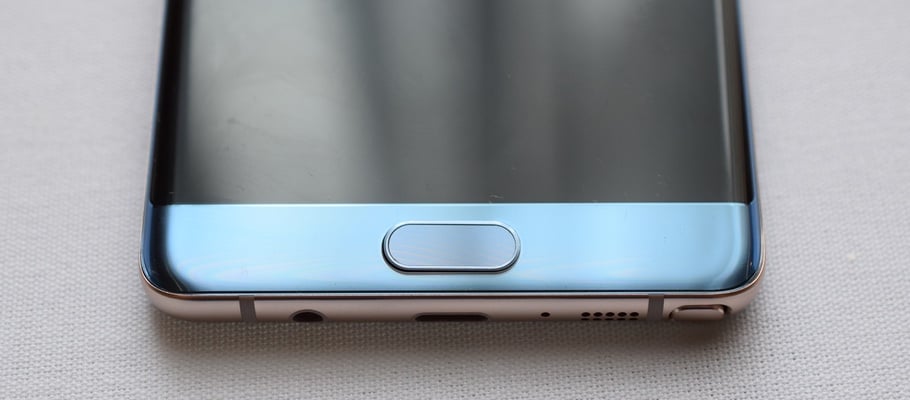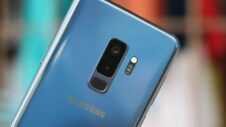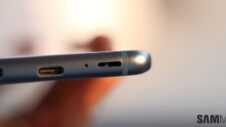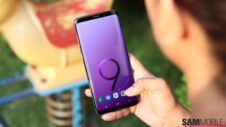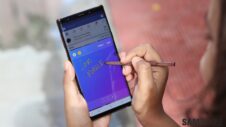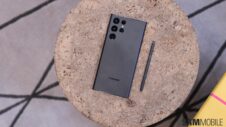It has consistently been rumored for the past few years that Samsung is going to introduce optical fingerprint recognition technology with a flagship smartphone. The Galaxy S8 was rumored to be the first commercially available smartphone with an in-display fingerprint sensor but that didn't happen. It decided against the idea because apparently, the technology wasn't ready.
We then heard the same rumors about the Galaxy Note 8 as well but even it didn't feature an in-display fingerprint sensor. Samsung reportedly abandoned the idea for the Galaxy Note 8 due to technical challenges, it was having a hard time manufacturing an integrated circuit that was to be placed under the display's surface to read the fingerprint image. With a Chinese manufacturer having launched a mid-range smartphone with an in-display fingerprint sensor this week, one has to ask Samsung why it's no longer leading the way in innovative smartphone technologies.
Samsung has missed the boat
US-based sensor manufacturer Synaptics unveiled its in-display fingerprint sensor last month. The company said that it would provide this component to smartphone manufacturers who want to add this functionality to their smartphones. Many thought that Samsung would use the in-display fingerprint sensor from Synaptics for the Galaxy S9 but given that we know what to expect from Galaxy S9, it's not going to have an in-display fingerprint sensor as well.
Synaptics demonstrated its in-display fingerprint sensor with China-based smartphone manufacturer Vivo at the Consumer Electronics Show 2018 earlier this month. The device it was demonstrated on didn't have a name or a launch date but it does now. The Vivo X20 Plus UD was officially launched earlier this week. It's the world's first commercially available smartphone with a fingerprint sensor that's integrated into the display itself.
Users don't have to participate in finger gymnastics in order to unlock their smartphone using the fingerprint sensor as they have to do on certain smartphones where the sensor's placement leaves a lot to be desired. They just need to place a finger on the screen. It's that simple and even though it might be just a little bit slower than conventional sensors, it's far from a gimmick or a novelty. The X20 Plus UD has a fully functional in-display fingerprint sensor and it goes without saying that the technology is only going to get better from here on out.
For the longest time, Samsung was expected to be the first company to take this bold step and put a handset on the market that introduced the world to this technology. That title now goes to Vivo. It's not like Vivo was striving for perfection here, the company didn't introduce this technology with a flagship device. The $520 X20 Plus UD is actually an upgraded model of its existing X20 Plus mid-range handset, it's powered by Qualcomm's Snapdragon 660 processor with 4GB RAM and features an 18:9 6.43-inch Super AMOLED display.
There's nothing forcing Samsung to introduce an in-display fingerprint sensor with a flagship smartphone. It can take a chance on this technology with a premium mid-range or even a regular mid-range device. It's not like the company doesn't add features to mid-range smartphones that aren't even available on its flagship handsets. Case in point: the dual front-facing camera on the Galaxy A8 (2018).
The surprising part is that Samsung might have bankrolled this achievement for Vivo itself. It was reported last year that Samsung had poured a lot of money into Synaptics' in-display fingerprint technology because it wanted the component to be ready in time for the Galaxy S8. Synaptics wasn't able to do that so Samsung ditched the idea. Technical challenges then forced Samsung to abandon the idea for the Galaxy Note 8 as well.
Synaptics has clearly made significant improvements since then otherwise Vivo wouldn't be releasing a smartphone with an unreliable component and it soon might not be the only company that beat Samsung to the market with this technology. Vivo is owned by BBK Electronics, a privately held Chinese mega-company that also owns Oppo and OnePlus. If the X20 Plus UD is well received in the company's home market it won't take long for either of those companies to push out a handset with an in-display fingerprint sensor.
Samsung has long been the leader in innovative smartphone technologies. It popularized OLED displays for smartphones and has made a significant contribution in shifting the market to larger display sizes for handsets. The company showcased its innovative spirit with experimental handsets like the Galaxy Round and the Galaxy Note Edge – two handsets that told the world just how far advanced the company's display technology was. They introduced us to the curved displays that the world fell in love with when Samsung used them in its flagship smartphones.
Nobody is asking Samsung to launch another experimental device that showcases the in-display fingerprint technology. A poll we conducted recently showed that not a lot of people are willing to buy experimental products regardless of how much they might cost, they will only consider them if the price isn't too high.
The fact remains, though, that Samsung appears to be losing its quality of flinging stuff against the wall just to see what sticks. It's this quality that brought about the second coming of the stylus with the Galaxy Note lineup at a time when many had written off this input method as a relic of the Palm handheld days. It's this quality that brought us gorgeous dual-edge curved displays that make it impossible for many to switch back to a flat panel.
If Samsung is bent on introducing an in-display fingerprint sensor with a flagship smartphone then we might have to wait until the fall this year when the Galaxy Note 9 will be due and even then there's no confirmation that this will happen. The Galaxy A8 (2018) was a missed opportunity because Samsung's key premium mid-range lineup has also been revamped now and its successor isn't due until early next year. For all we know, Samsung might not launch a device with an in-display fingerprint sensor until 2019 and it's highly likely that multiple Chinese OEMs will have launched theirs by then.
Do you think that Samsung's innovative edge that was behind some of its greatest products ever is fading? Should the company be doing more than just improvements to its existing technologies? Share your thoughts with us in the comments below.
